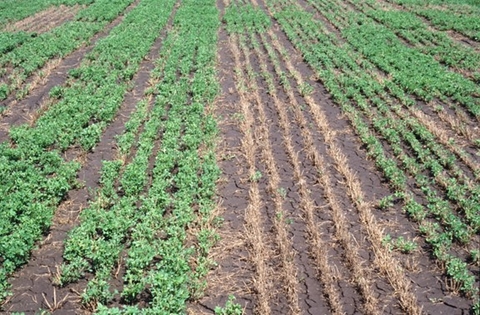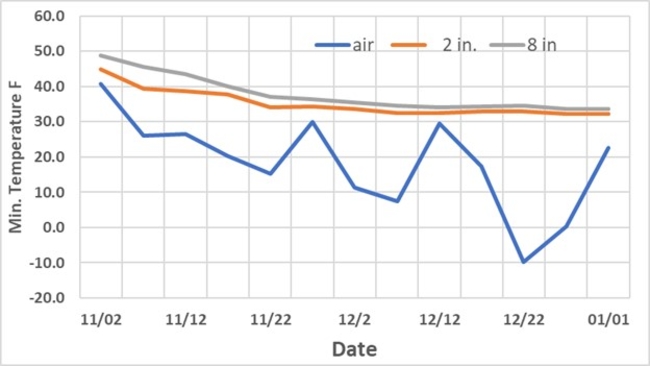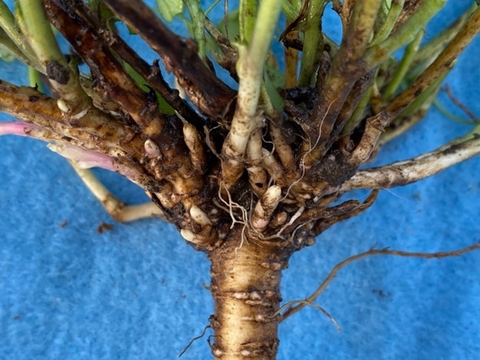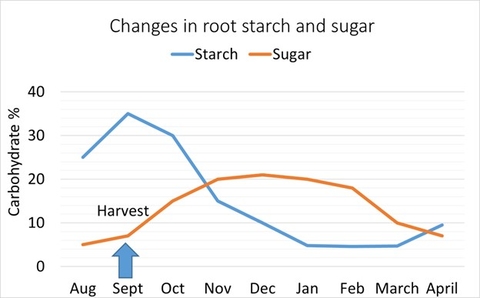Quick facts
- Weather factors, such as air temperatures, snow depth, and ice sheeting, affect winter survival.
- Management practices can reduce the risk of winter injury, including variety selection, cutting schedules, and fall harvest dates.
- Assess your risk of winter injury with the Winter Injury Calculator.
Many factors can contribute to winter injury of an alfalfa stand. There are uncontrollable factors, such as snow cover and air temperatures, but there are also management strategies to reduce the risk of winter injury.
Weather factors affecting winter survival
Winter air temperatures
Dormant alfalfa varieties can suffer winter injury at temperatures ranging from 5 to 15°F. Winter injury occurs because ice crystals form within and among plant cells and damage cell membranes.
In contrast, periods of warm soil temperatures (more than 41 degrees) in later winter and spring can cause alfalfa to deharden and break dormancy. If followed by extreme cold or icy weather, severe winter injury may result.
Ice sheeting
Ice sheets can develop following snow melt or freezing rain. Ice sheets smother alfalfa plants by preventing air exchange to alfalfa crowns. When this diffusion is restricted, carbon dioxide accumulates around the plants. Normal pathways of aerobic respiration are disrupted and anaerobic respiration predominates. As a result, plants use energy reserves at an accelerated rate and toxic metabolites like ethanol and lactate accumulate. Alfalfa can tolerate up to four weeks of ice sheeting.
Soil moisture
Wet soils in the fall can affect alfalfa's dormancy reaction that reduces free water within and among plant cells. Cellular damage occurs when water freezes.
Snow depth
Snow depth is critical for insulating the soil. Snow depths of 4 to 8 inches have been shown to provide effective insulation for alfalfa. Snow reflects solar energy and reduces energy absorption that can cause soil warming during the winter. It can also protect alfalfa from very low air temperatures. As figure 1 illustrates, soil temperatures held steady during the very cold periods of December, 2022, when between 4 and 8 inches of snow covered the ground.
Alfalfa management to reduce winter injury risk
As shown in Figure 1, there are many interacting risk factors that affect alfalfa winter survival. Some of those risks can be minimized by management. The most important practices include the following:
Stand age
Older alfalfa stands often have plants with crown injury and disease. Younger stands are healthier and better able to stand winter stress.
Variety selection
Select varieties that are adapted to the soils and climate in a region to ensure the appropriate winter hardiness and disease resistance.
Soil fertility and pest management
Plants stressed pests or by low nutrient levels are weaker and more susceptible to winter injury. Soil test for potassium, phosphorus, and sulfur levels and follow University of Minnesota Extension fertilizer guidelines.
Potato leafhopper and alfalfa weevil are the most important economic insect pests of alfalfa. Scout to monitor insect populations and use economic thresholds when treating with insecticides.
Soil moisture
Wet soils can lead to greater freeze-thaw action during the winter and decreases hardening of alfalfa during the fall. Alfalfa should not be grown on soils that retain water or in low-lying areas within a field. Avoid fall irrigation.
Harvest management to reduce winter injury risk
When alfalfa regrows after each cutting, it utilizes carbohydrates - sugars and starch - stored in the root and crown. Stand persistence is greatest when harvests are timed at the flowering stage throughout the growing season, because carbohydrate reserves are maximized. Carboyhydrate reserves are less when alfalfa is harvested at the bud stage.
As a result, a three-cut harvest system at flowering is less stressful than a four-cut harvest schedule at the bud stage. For most of Minnesota, a fourth or even fifth cut in the fall will be riskier than a third cut.
No cutting is recommended between September 1 and October 15 - the average date of the first killing frost. Alfalfa is a perennial plant that depends on fall dormancy to prepare for winter survival and fall cutting can disrupt its fall dormancy reaction.
Shortening day lengths and declining temperatures in the fall trigger alfalfa to decrease above-ground herbage production and to develop crown buds instead (Figure 2). Crown buds located below the soil surface are very winter hardy and the source of spring regrowth.
Alfalfa metabolism also changes during the fall dormancy reaction. To prepare for winter, the plant stores energy in the form of starch and sugars, alters protein metabolism, and decreases free water in the plant cells. The stored starch is converted to sugars during the winter, sustaining the plant (Figure 3).
Cutting or grazing alfalfa anytime in September will disrupt this storage, leading to insufficient energy supplies for overwintering. Rather than storing energy, plants cut during this sensitive time will expend energy on regrowth. Crown buds that would have normally overwintered and started regrowth in the spring begin to grow after a late fall harvest instead. There isn't enough time for sufficient regrowth for the plant to resume the normal dormancy reaction. By using its energy reserves for regrowth in the fall, alfalfa is exposed to greater risk of winter injury.
Alfalfa will continue to store energy until the onset of freezing temperatures in late fall. Temperatures about 24°F will cause visible damage, but the plant can continue to grow using the remaining leaf area. From central to southeast Minnesota, there is a 50% chance that the temperature will fall to 24°F or colder about mid-October. Information for specific regions is available from the DNR: First fall freeze and frost date probabilities.
Harvesting alfalfa on these dates or later is generally considered to be safe as little regrowth will occur. Delaying cutting until mid-October will allow for high levels of carbohydrate reserves while minimizing the likelihood of winter injury.
Another way to more precisely determine the final cutting date for alfalfa is based on growing degree days (GDD) as described Late summer cutting management of alfalfa from the University of Wisconsin. Cutting when <200 GDD remain in the growing season ensures that there will be insufficient regrowth to use root carbohydrates.
Growing degree days for alfalfa are determined by averaging the high and low temperatures for a day, then subtracting the base temperature of 41°F. At 41°F, alfalfa growth is negligible. For example, if the daily high was 70°F and the daily low was 42°F, the average is 56°F. Subtract the base 41°F and you have 13 alfalfa GDD accumulated for that day.
At constant or decreasing temperatures, alfalfa can be safely cut about 15 days before the average date of 24°F air temperatures. Therefore, there is flexibility on the date of the final cutting and we do not need to wait for killing temperatures of 24°F. Given the air temperature example above, if the average date of 24°F air temperature occurs in mid-October, in an average year cutting can occur as early as 1 October without risk.
At the last fall cutting, 6 inches of stubble should remain. Unharvested stubble is valuable to catch snow and to buffer against premature midwinter warmup of the soil should temperatures rise above freezing. Unharvested stubble will not smother alfalfa plants. Winter weather causes leaves to die and fall to the ground while remaining stems desiccate. These stems degrade by the time of the early spring harvest and do not affect forage yield or quality of the first harvest.
Winter injury risk
Reviewed in 2023





